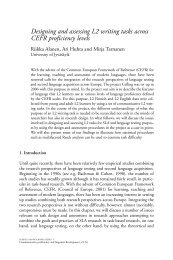BOOK OF ABSTRACTS - EUROSLA
BOOK OF ABSTRACTS - EUROSLA
BOOK OF ABSTRACTS - EUROSLA
Create successful ePaper yourself
Turn your PDF publications into a flip-book with our unique Google optimized e-Paper software.
y learners from a wide range of language backgrounds. Examples of L2<br />
oral corpora include the French L2 projects InterFra<br />
(http://www.fraita.su.se/interfra/), based at the University of Stockholm,<br />
FLLOC (http://www.flloc.soton.ac.uk) at the Universities of Southampton<br />
and Newcastle/Essex, and a similar corpus for L2 learner Spanish<br />
(www.splloc.soton.ac.uk), based at the universities of Southampton,<br />
Newcastle/Essex and York. Further publicly accessible examples of oral<br />
corpora for both L2 English and L2 French are available on the Talkbank<br />
project website at http://talkbank.org/data/SLA. Researchers associated with<br />
Talkbank, FLLOC and SPLLOC are making use of CHILDES conventions<br />
and analysis software developed initially for L1 acquisition research to<br />
support their research programmes (http://childes.psy.cmu.edu); others are<br />
developing dedicated tools to analyse morphosyntactic and/ or lexical<br />
characteristics of L2 corpora (Granfeldt et al 2006; Malvern & Richards<br />
2002).The first part of the talk will briefly review these corpora and their<br />
design features.<br />
In spite of this increase in the range of corpora available, however, second<br />
language researchers have been rather slow in taking advantage of them and<br />
their associated computerised methodologies. The second part of the talk<br />
will argue the theoretical and empirical case for the need for SLA research<br />
methodologies to move into the digital age. It will then outline the<br />
possibilities offered by such tools for addressing varied research agendas,<br />
illustrating from the web-based databases of French and Spanish Learner<br />
Language Oral Corpora (FLLOC and SPLLOC; Mitchell et al. 2008; Myles<br />
2007a, 2007b), containing over 3 million words (transcripts, soundfiles,<br />
tagged transcripts) from learners at different levels (www.flloc.soton.ac.uk;<br />
www.spploc.soton.ac.uk). The CHILDES suite of software tools used in<br />
these database for storing, transcribing and analysing the data will be<br />
presented, as well as some of the adaptations made to it for SLA-specific<br />
research purposes. The automatic morphosyntactic tagger will then be<br />
demonstrated, as well as searches carried out directly on the morphosyntactic<br />
output on large batches of files, in order to address specific research<br />
questions.<br />
The last part of the talk will outline how substantive programmes of<br />
research on L2 oral and written corpora are contributing to a range of SLA<br />
issues, from the overall modelling of stages in learner development (e.g.<br />
Bartning & Schlyter 2004) to learner profiling (Granfeldt et al 2006) as well<br />
as to research on L2 morphosyntactic development (e.g. Arche &<br />
Dominguez 2011; Dominguez et al 2011; Myles 2005; Rule & Marsden<br />
2006), on formulaic language (e.g. Meunier & Granger 2008; Myles 2004),<br />
and on L2 pragmatic development (e.g. Belz & Kinginger 2003; Granget<br />
2003; Guillot 2009). The talk will conclude with a discussion of a possible<br />
agenda for the further development of corpus-based research in SLA, paying<br />
particular attention to issues of design principles, software availability and<br />
8



